Report on Education and Training: Assessment, Theories, and Learning
VerifiedAdded on 2023/01/19
|27
|8996
|55
Report
AI Summary
This report provides a comprehensive overview of education and training, specifically focusing on assessment methods within a nursing education context. It begins by examining the role and utilization of initial and diagnostic assessments in establishing learning goals, emphasizing their significance in identifying and meeting the diverse learning needs of primary students. The report then illustrates ten different assessment methods, detailing their purposes and outcomes. Furthermore, it explores various communication theories and their impact on learning, analyzing the benefits and limitations of different communication strategies. Finally, the report addresses individual learning and evaluation, culminating in a conclusion that synthesizes the key findings and recommendations for effective education and training practices.
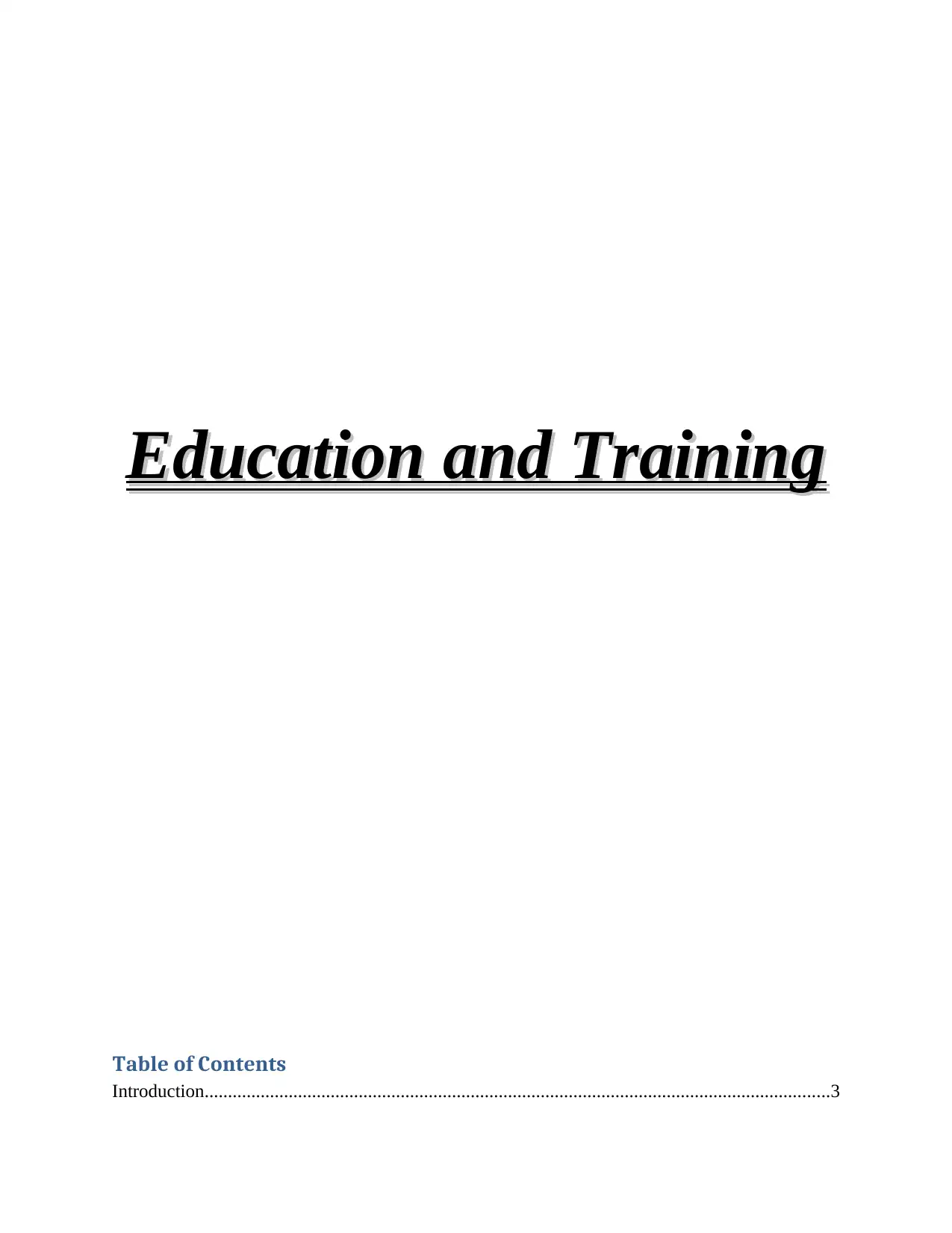
Education and TrainingEducation and Training
Table of Contents
Introduction......................................................................................................................................3
Table of Contents
Introduction......................................................................................................................................3
Paraphrase This Document
Need a fresh take? Get an instant paraphrase of this document with our AI Paraphraser
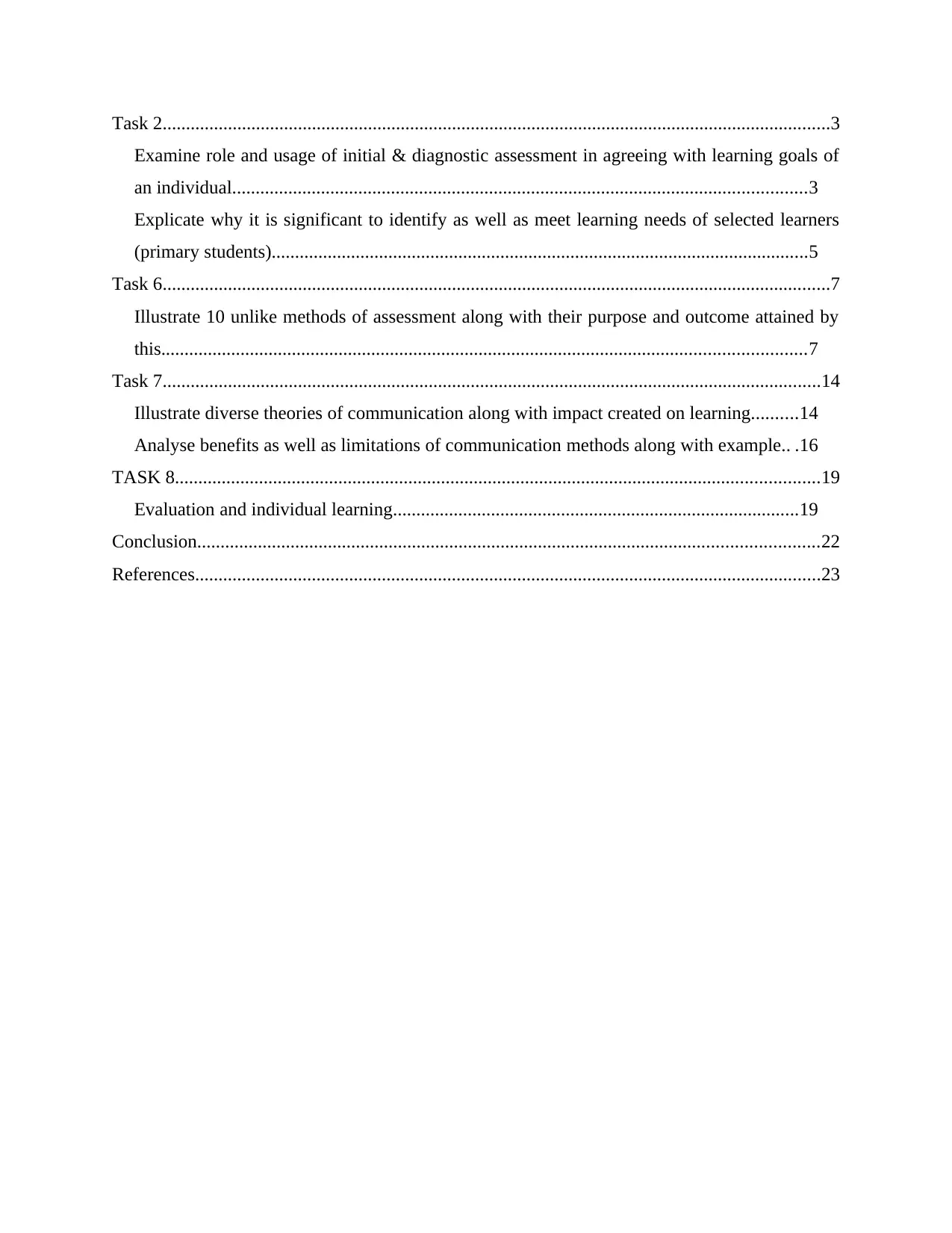
Task 2...............................................................................................................................................3
Examine role and usage of initial & diagnostic assessment in agreeing with learning goals of
an individual...........................................................................................................................3
Explicate why it is significant to identify as well as meet learning needs of selected learners
(primary students)...................................................................................................................5
Task 6...............................................................................................................................................7
Illustrate 10 unlike methods of assessment along with their purpose and outcome attained by
this..........................................................................................................................................7
Task 7.............................................................................................................................................14
Illustrate diverse theories of communication along with impact created on learning..........14
Analyse benefits as well as limitations of communication methods along with example.. .16
TASK 8..........................................................................................................................................19
Evaluation and individual learning.......................................................................................19
Conclusion.....................................................................................................................................22
References......................................................................................................................................23
Examine role and usage of initial & diagnostic assessment in agreeing with learning goals of
an individual...........................................................................................................................3
Explicate why it is significant to identify as well as meet learning needs of selected learners
(primary students)...................................................................................................................5
Task 6...............................................................................................................................................7
Illustrate 10 unlike methods of assessment along with their purpose and outcome attained by
this..........................................................................................................................................7
Task 7.............................................................................................................................................14
Illustrate diverse theories of communication along with impact created on learning..........14
Analyse benefits as well as limitations of communication methods along with example.. .16
TASK 8..........................................................................................................................................19
Evaluation and individual learning.......................................................................................19
Conclusion.....................................................................................................................................22
References......................................................................................................................................23
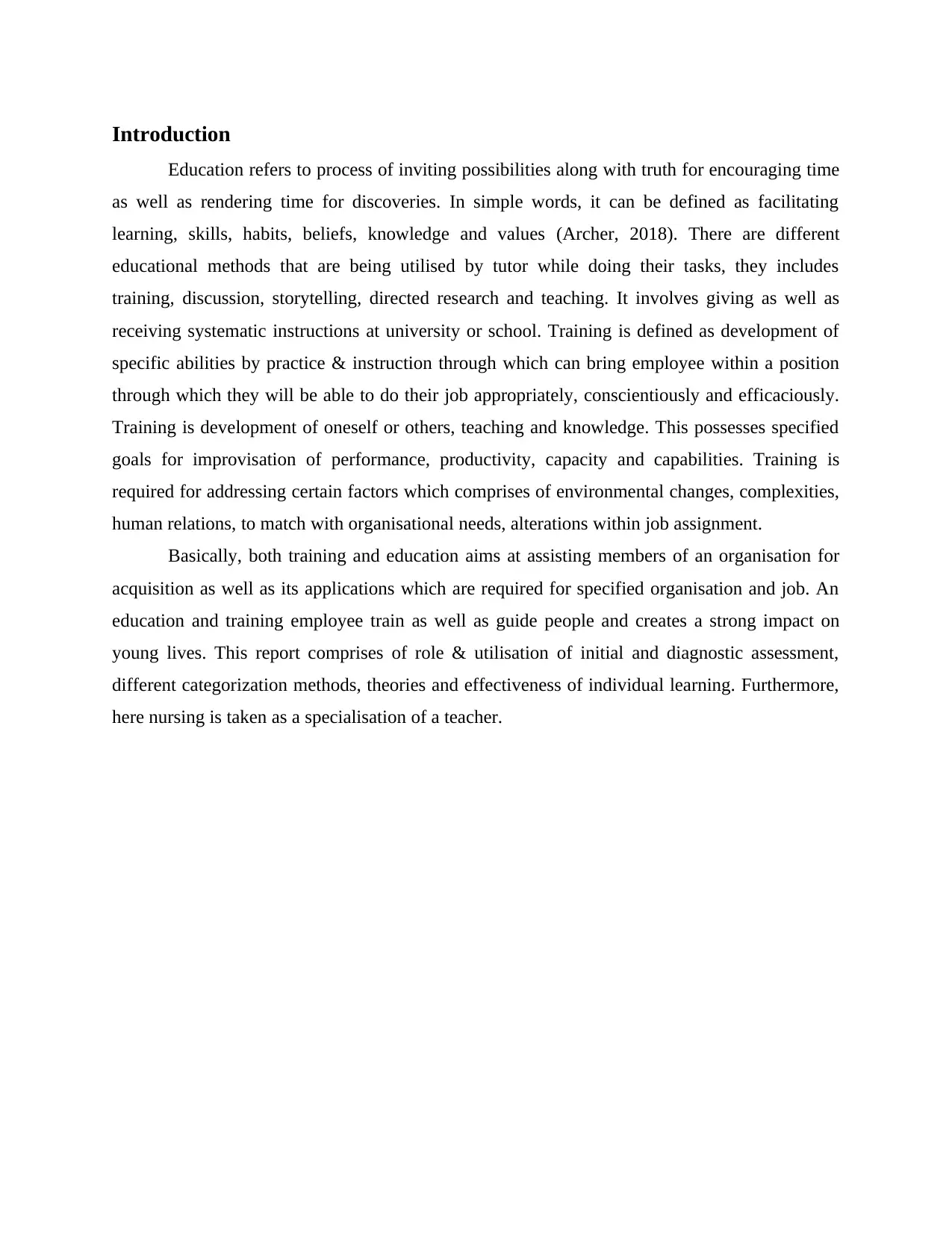
Introduction
Education refers to process of inviting possibilities along with truth for encouraging time
as well as rendering time for discoveries. In simple words, it can be defined as facilitating
learning, skills, habits, beliefs, knowledge and values (Archer, 2018). There are different
educational methods that are being utilised by tutor while doing their tasks, they includes
training, discussion, storytelling, directed research and teaching. It involves giving as well as
receiving systematic instructions at university or school. Training is defined as development of
specific abilities by practice & instruction through which can bring employee within a position
through which they will be able to do their job appropriately, conscientiously and efficaciously.
Training is development of oneself or others, teaching and knowledge. This possesses specified
goals for improvisation of performance, productivity, capacity and capabilities. Training is
required for addressing certain factors which comprises of environmental changes, complexities,
human relations, to match with organisational needs, alterations within job assignment.
Basically, both training and education aims at assisting members of an organisation for
acquisition as well as its applications which are required for specified organisation and job. An
education and training employee train as well as guide people and creates a strong impact on
young lives. This report comprises of role & utilisation of initial and diagnostic assessment,
different categorization methods, theories and effectiveness of individual learning. Furthermore,
here nursing is taken as a specialisation of a teacher.
Education refers to process of inviting possibilities along with truth for encouraging time
as well as rendering time for discoveries. In simple words, it can be defined as facilitating
learning, skills, habits, beliefs, knowledge and values (Archer, 2018). There are different
educational methods that are being utilised by tutor while doing their tasks, they includes
training, discussion, storytelling, directed research and teaching. It involves giving as well as
receiving systematic instructions at university or school. Training is defined as development of
specific abilities by practice & instruction through which can bring employee within a position
through which they will be able to do their job appropriately, conscientiously and efficaciously.
Training is development of oneself or others, teaching and knowledge. This possesses specified
goals for improvisation of performance, productivity, capacity and capabilities. Training is
required for addressing certain factors which comprises of environmental changes, complexities,
human relations, to match with organisational needs, alterations within job assignment.
Basically, both training and education aims at assisting members of an organisation for
acquisition as well as its applications which are required for specified organisation and job. An
education and training employee train as well as guide people and creates a strong impact on
young lives. This report comprises of role & utilisation of initial and diagnostic assessment,
different categorization methods, theories and effectiveness of individual learning. Furthermore,
here nursing is taken as a specialisation of a teacher.
⊘ This is a preview!⊘
Do you want full access?
Subscribe today to unlock all pages.

Trusted by 1+ million students worldwide
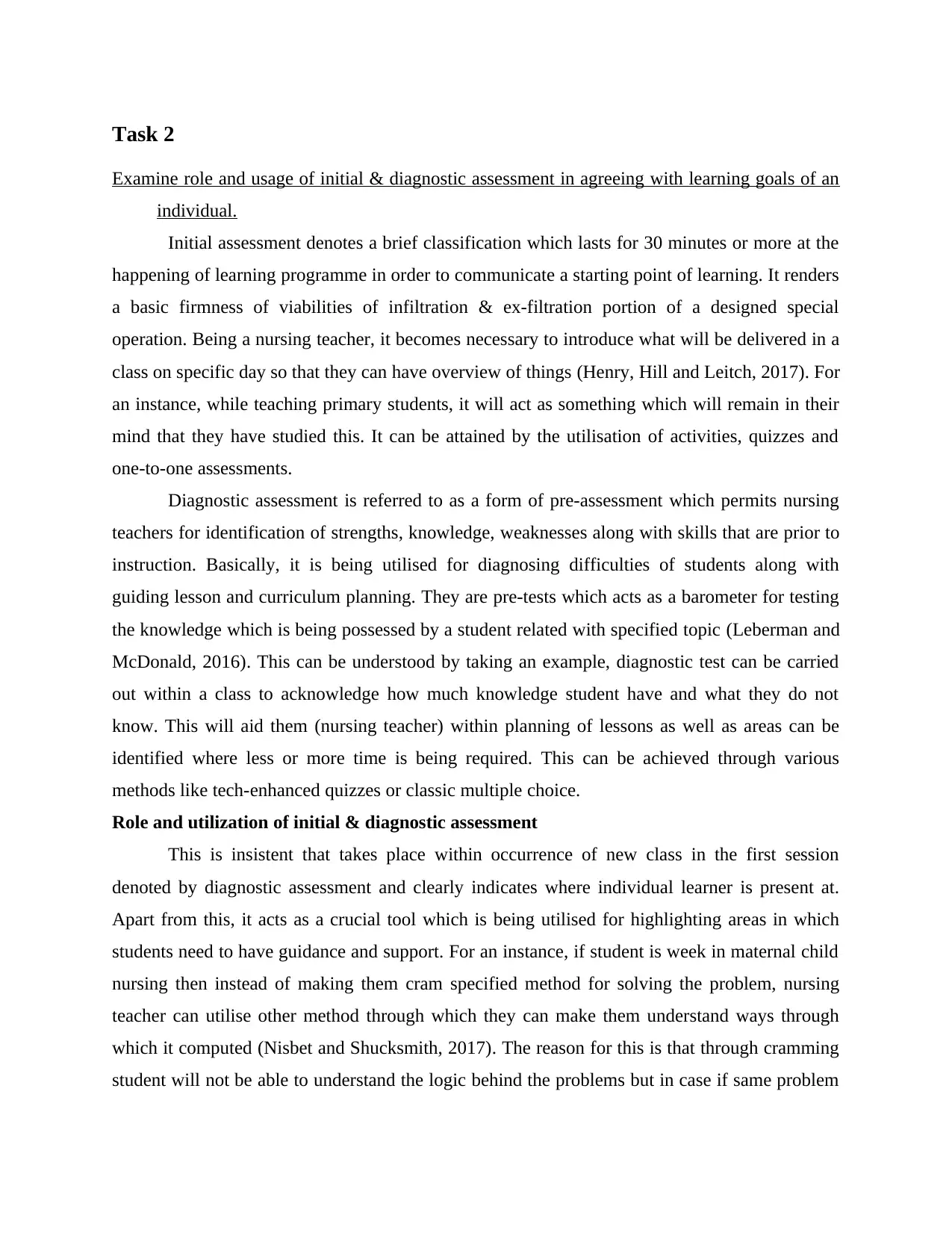
Task 2
Examine role and usage of initial & diagnostic assessment in agreeing with learning goals of an
individual.
Initial assessment denotes a brief classification which lasts for 30 minutes or more at the
happening of learning programme in order to communicate a starting point of learning. It renders
a basic firmness of viabilities of infiltration & ex-filtration portion of a designed special
operation. Being a nursing teacher, it becomes necessary to introduce what will be delivered in a
class on specific day so that they can have overview of things (Henry, Hill and Leitch, 2017). For
an instance, while teaching primary students, it will act as something which will remain in their
mind that they have studied this. It can be attained by the utilisation of activities, quizzes and
one-to-one assessments.
Diagnostic assessment is referred to as a form of pre-assessment which permits nursing
teachers for identification of strengths, knowledge, weaknesses along with skills that are prior to
instruction. Basically, it is being utilised for diagnosing difficulties of students along with
guiding lesson and curriculum planning. They are pre-tests which acts as a barometer for testing
the knowledge which is being possessed by a student related with specified topic (Leberman and
McDonald, 2016). This can be understood by taking an example, diagnostic test can be carried
out within a class to acknowledge how much knowledge student have and what they do not
know. This will aid them (nursing teacher) within planning of lessons as well as areas can be
identified where less or more time is being required. This can be achieved through various
methods like tech-enhanced quizzes or classic multiple choice.
Role and utilization of initial & diagnostic assessment
This is insistent that takes place within occurrence of new class in the first session
denoted by diagnostic assessment and clearly indicates where individual learner is present at.
Apart from this, it acts as a crucial tool which is being utilised for highlighting areas in which
students need to have guidance and support. For an instance, if student is week in maternal child
nursing then instead of making them cram specified method for solving the problem, nursing
teacher can utilise other method through which they can make them understand ways through
which it computed (Nisbet and Shucksmith, 2017). The reason for this is that through cramming
student will not be able to understand the logic behind the problems but in case if same problem
Examine role and usage of initial & diagnostic assessment in agreeing with learning goals of an
individual.
Initial assessment denotes a brief classification which lasts for 30 minutes or more at the
happening of learning programme in order to communicate a starting point of learning. It renders
a basic firmness of viabilities of infiltration & ex-filtration portion of a designed special
operation. Being a nursing teacher, it becomes necessary to introduce what will be delivered in a
class on specific day so that they can have overview of things (Henry, Hill and Leitch, 2017). For
an instance, while teaching primary students, it will act as something which will remain in their
mind that they have studied this. It can be attained by the utilisation of activities, quizzes and
one-to-one assessments.
Diagnostic assessment is referred to as a form of pre-assessment which permits nursing
teachers for identification of strengths, knowledge, weaknesses along with skills that are prior to
instruction. Basically, it is being utilised for diagnosing difficulties of students along with
guiding lesson and curriculum planning. They are pre-tests which acts as a barometer for testing
the knowledge which is being possessed by a student related with specified topic (Leberman and
McDonald, 2016). This can be understood by taking an example, diagnostic test can be carried
out within a class to acknowledge how much knowledge student have and what they do not
know. This will aid them (nursing teacher) within planning of lessons as well as areas can be
identified where less or more time is being required. This can be achieved through various
methods like tech-enhanced quizzes or classic multiple choice.
Role and utilization of initial & diagnostic assessment
This is insistent that takes place within occurrence of new class in the first session
denoted by diagnostic assessment and clearly indicates where individual learner is present at.
Apart from this, it acts as a crucial tool which is being utilised for highlighting areas in which
students need to have guidance and support. For an instance, if student is week in maternal child
nursing then instead of making them cram specified method for solving the problem, nursing
teacher can utilise other method through which they can make them understand ways through
which it computed (Nisbet and Shucksmith, 2017). The reason for this is that through cramming
student will not be able to understand the logic behind the problems but in case if same problem
Paraphrase This Document
Need a fresh take? Get an instant paraphrase of this document with our AI Paraphraser
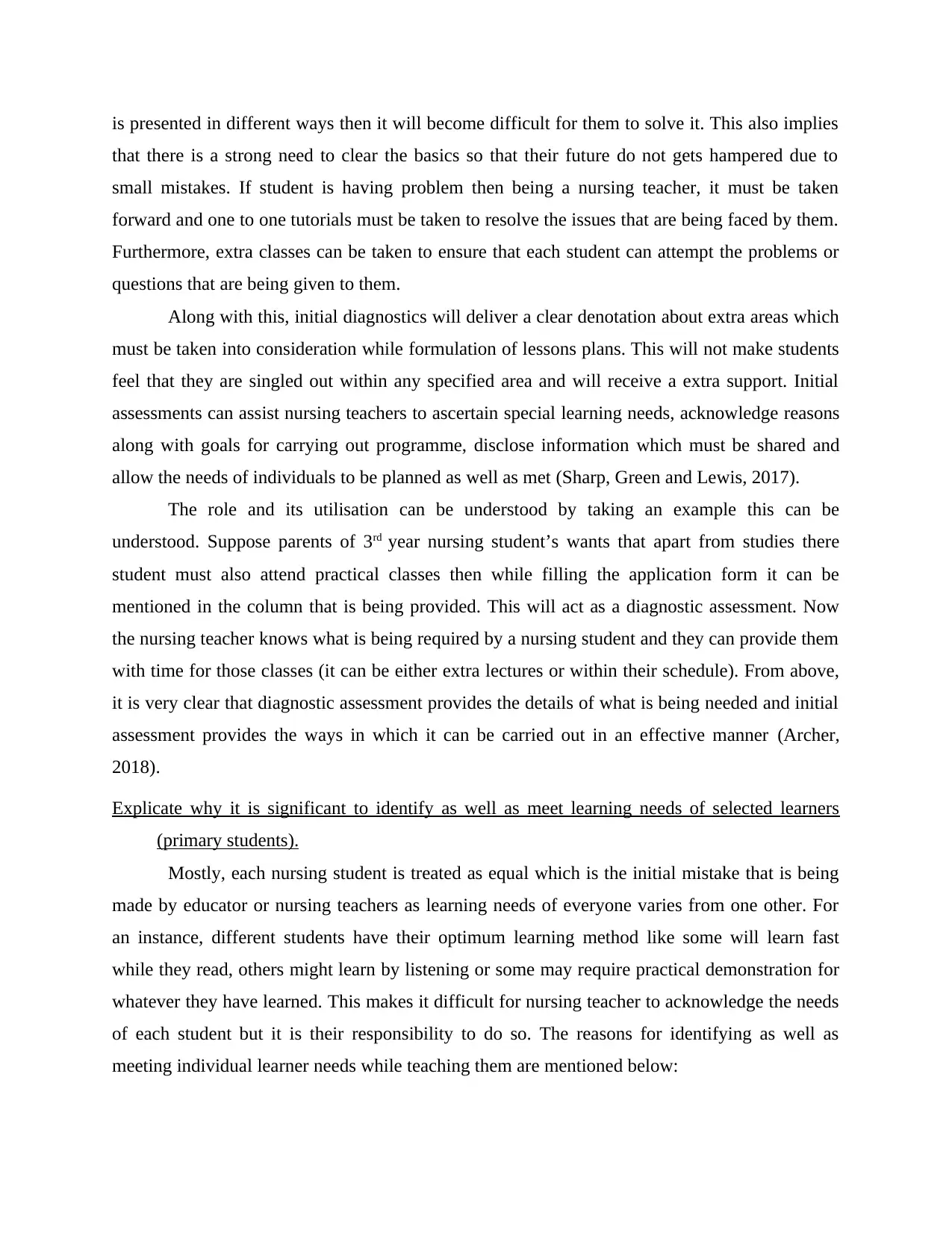
is presented in different ways then it will become difficult for them to solve it. This also implies
that there is a strong need to clear the basics so that their future do not gets hampered due to
small mistakes. If student is having problem then being a nursing teacher, it must be taken
forward and one to one tutorials must be taken to resolve the issues that are being faced by them.
Furthermore, extra classes can be taken to ensure that each student can attempt the problems or
questions that are being given to them.
Along with this, initial diagnostics will deliver a clear denotation about extra areas which
must be taken into consideration while formulation of lessons plans. This will not make students
feel that they are singled out within any specified area and will receive a extra support. Initial
assessments can assist nursing teachers to ascertain special learning needs, acknowledge reasons
along with goals for carrying out programme, disclose information which must be shared and
allow the needs of individuals to be planned as well as met (Sharp, Green and Lewis, 2017).
The role and its utilisation can be understood by taking an example this can be
understood. Suppose parents of 3rd year nursing student’s wants that apart from studies there
student must also attend practical classes then while filling the application form it can be
mentioned in the column that is being provided. This will act as a diagnostic assessment. Now
the nursing teacher knows what is being required by a nursing student and they can provide them
with time for those classes (it can be either extra lectures or within their schedule). From above,
it is very clear that diagnostic assessment provides the details of what is being needed and initial
assessment provides the ways in which it can be carried out in an effective manner (Archer,
2018).
Explicate why it is significant to identify as well as meet learning needs of selected learners
(primary students).
Mostly, each nursing student is treated as equal which is the initial mistake that is being
made by educator or nursing teachers as learning needs of everyone varies from one other. For
an instance, different students have their optimum learning method like some will learn fast
while they read, others might learn by listening or some may require practical demonstration for
whatever they have learned. This makes it difficult for nursing teacher to acknowledge the needs
of each student but it is their responsibility to do so. The reasons for identifying as well as
meeting individual learner needs while teaching them are mentioned below:
that there is a strong need to clear the basics so that their future do not gets hampered due to
small mistakes. If student is having problem then being a nursing teacher, it must be taken
forward and one to one tutorials must be taken to resolve the issues that are being faced by them.
Furthermore, extra classes can be taken to ensure that each student can attempt the problems or
questions that are being given to them.
Along with this, initial diagnostics will deliver a clear denotation about extra areas which
must be taken into consideration while formulation of lessons plans. This will not make students
feel that they are singled out within any specified area and will receive a extra support. Initial
assessments can assist nursing teachers to ascertain special learning needs, acknowledge reasons
along with goals for carrying out programme, disclose information which must be shared and
allow the needs of individuals to be planned as well as met (Sharp, Green and Lewis, 2017).
The role and its utilisation can be understood by taking an example this can be
understood. Suppose parents of 3rd year nursing student’s wants that apart from studies there
student must also attend practical classes then while filling the application form it can be
mentioned in the column that is being provided. This will act as a diagnostic assessment. Now
the nursing teacher knows what is being required by a nursing student and they can provide them
with time for those classes (it can be either extra lectures or within their schedule). From above,
it is very clear that diagnostic assessment provides the details of what is being needed and initial
assessment provides the ways in which it can be carried out in an effective manner (Archer,
2018).
Explicate why it is significant to identify as well as meet learning needs of selected learners
(primary students).
Mostly, each nursing student is treated as equal which is the initial mistake that is being
made by educator or nursing teachers as learning needs of everyone varies from one other. For
an instance, different students have their optimum learning method like some will learn fast
while they read, others might learn by listening or some may require practical demonstration for
whatever they have learned. This makes it difficult for nursing teacher to acknowledge the needs
of each student but it is their responsibility to do so. The reasons for identifying as well as
meeting individual learner needs while teaching them are mentioned below:
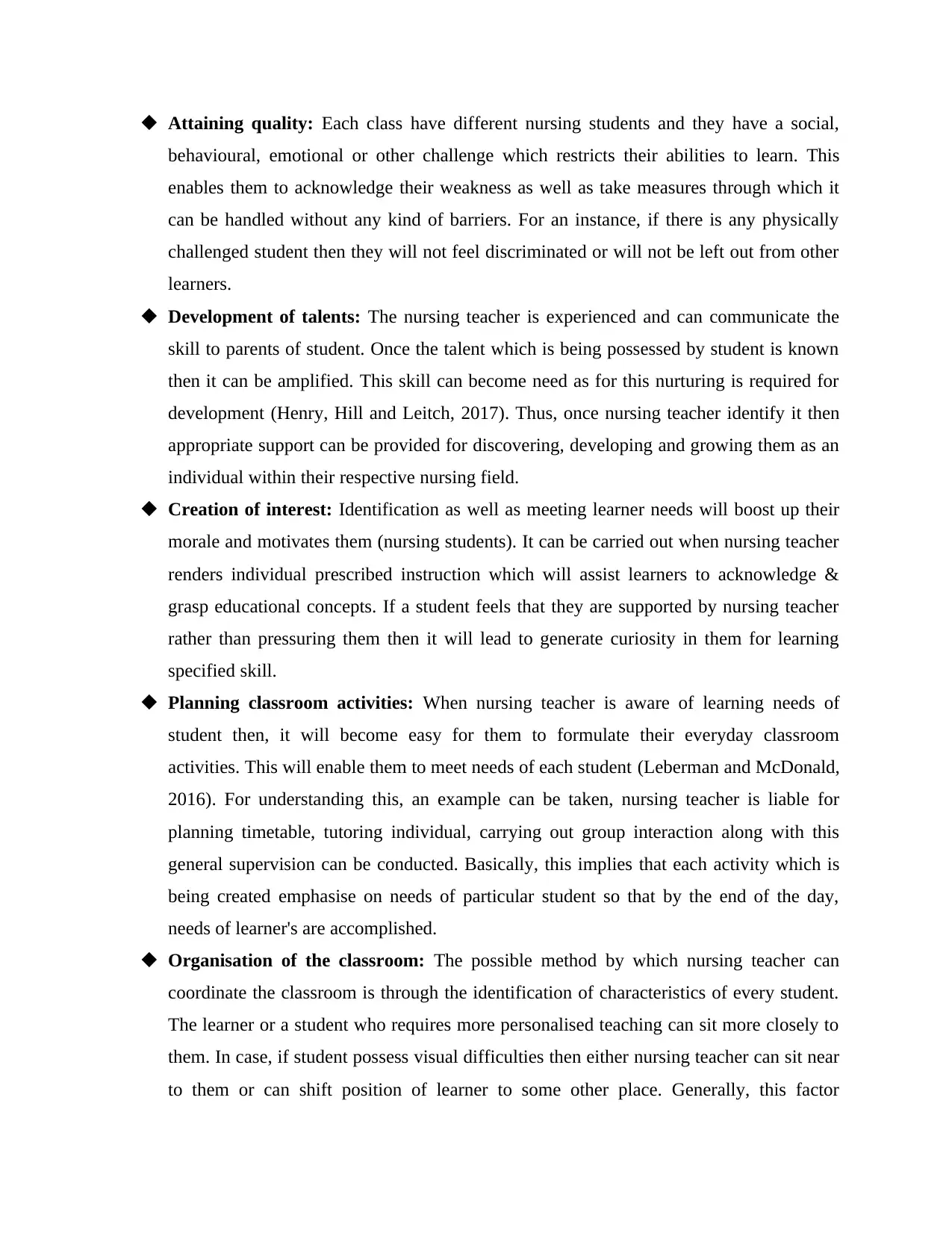
Attaining quality: Each class have different nursing students and they have a social,
behavioural, emotional or other challenge which restricts their abilities to learn. This
enables them to acknowledge their weakness as well as take measures through which it
can be handled without any kind of barriers. For an instance, if there is any physically
challenged student then they will not feel discriminated or will not be left out from other
learners.
Development of talents: The nursing teacher is experienced and can communicate the
skill to parents of student. Once the talent which is being possessed by student is known
then it can be amplified. This skill can become need as for this nurturing is required for
development (Henry, Hill and Leitch, 2017). Thus, once nursing teacher identify it then
appropriate support can be provided for discovering, developing and growing them as an
individual within their respective nursing field.
Creation of interest: Identification as well as meeting learner needs will boost up their
morale and motivates them (nursing students). It can be carried out when nursing teacher
renders individual prescribed instruction which will assist learners to acknowledge &
grasp educational concepts. If a student feels that they are supported by nursing teacher
rather than pressuring them then it will lead to generate curiosity in them for learning
specified skill.
Planning classroom activities: When nursing teacher is aware of learning needs of
student then, it will become easy for them to formulate their everyday classroom
activities. This will enable them to meet needs of each student (Leberman and McDonald,
2016). For understanding this, an example can be taken, nursing teacher is liable for
planning timetable, tutoring individual, carrying out group interaction along with this
general supervision can be conducted. Basically, this implies that each activity which is
being created emphasise on needs of particular student so that by the end of the day,
needs of learner's are accomplished.
Organisation of the classroom: The possible method by which nursing teacher can
coordinate the classroom is through the identification of characteristics of every student.
The learner or a student who requires more personalised teaching can sit more closely to
them. In case, if student possess visual difficulties then either nursing teacher can sit near
to them or can shift position of learner to some other place. Generally, this factor
behavioural, emotional or other challenge which restricts their abilities to learn. This
enables them to acknowledge their weakness as well as take measures through which it
can be handled without any kind of barriers. For an instance, if there is any physically
challenged student then they will not feel discriminated or will not be left out from other
learners.
Development of talents: The nursing teacher is experienced and can communicate the
skill to parents of student. Once the talent which is being possessed by student is known
then it can be amplified. This skill can become need as for this nurturing is required for
development (Henry, Hill and Leitch, 2017). Thus, once nursing teacher identify it then
appropriate support can be provided for discovering, developing and growing them as an
individual within their respective nursing field.
Creation of interest: Identification as well as meeting learner needs will boost up their
morale and motivates them (nursing students). It can be carried out when nursing teacher
renders individual prescribed instruction which will assist learners to acknowledge &
grasp educational concepts. If a student feels that they are supported by nursing teacher
rather than pressuring them then it will lead to generate curiosity in them for learning
specified skill.
Planning classroom activities: When nursing teacher is aware of learning needs of
student then, it will become easy for them to formulate their everyday classroom
activities. This will enable them to meet needs of each student (Leberman and McDonald,
2016). For understanding this, an example can be taken, nursing teacher is liable for
planning timetable, tutoring individual, carrying out group interaction along with this
general supervision can be conducted. Basically, this implies that each activity which is
being created emphasise on needs of particular student so that by the end of the day,
needs of learner's are accomplished.
Organisation of the classroom: The possible method by which nursing teacher can
coordinate the classroom is through the identification of characteristics of every student.
The learner or a student who requires more personalised teaching can sit more closely to
them. In case, if student possess visual difficulties then either nursing teacher can sit near
to them or can shift position of learner to some other place. Generally, this factor
⊘ This is a preview!⊘
Do you want full access?
Subscribe today to unlock all pages.

Trusted by 1+ million students worldwide
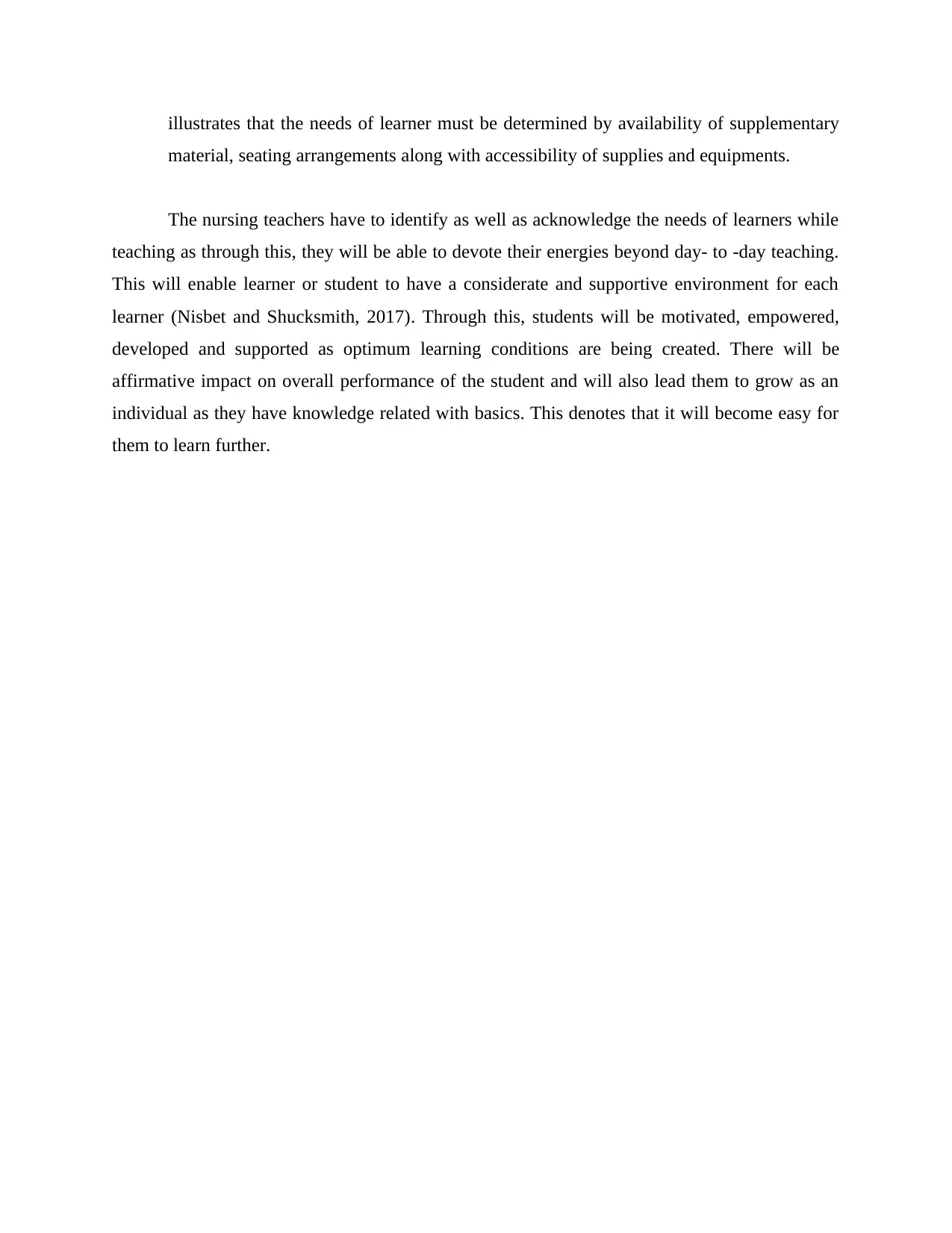
illustrates that the needs of learner must be determined by availability of supplementary
material, seating arrangements along with accessibility of supplies and equipments.
The nursing teachers have to identify as well as acknowledge the needs of learners while
teaching as through this, they will be able to devote their energies beyond day- to -day teaching.
This will enable learner or student to have a considerate and supportive environment for each
learner (Nisbet and Shucksmith, 2017). Through this, students will be motivated, empowered,
developed and supported as optimum learning conditions are being created. There will be
affirmative impact on overall performance of the student and will also lead them to grow as an
individual as they have knowledge related with basics. This denotes that it will become easy for
them to learn further.
material, seating arrangements along with accessibility of supplies and equipments.
The nursing teachers have to identify as well as acknowledge the needs of learners while
teaching as through this, they will be able to devote their energies beyond day- to -day teaching.
This will enable learner or student to have a considerate and supportive environment for each
learner (Nisbet and Shucksmith, 2017). Through this, students will be motivated, empowered,
developed and supported as optimum learning conditions are being created. There will be
affirmative impact on overall performance of the student and will also lead them to grow as an
individual as they have knowledge related with basics. This denotes that it will become easy for
them to learn further.
Paraphrase This Document
Need a fresh take? Get an instant paraphrase of this document with our AI Paraphraser
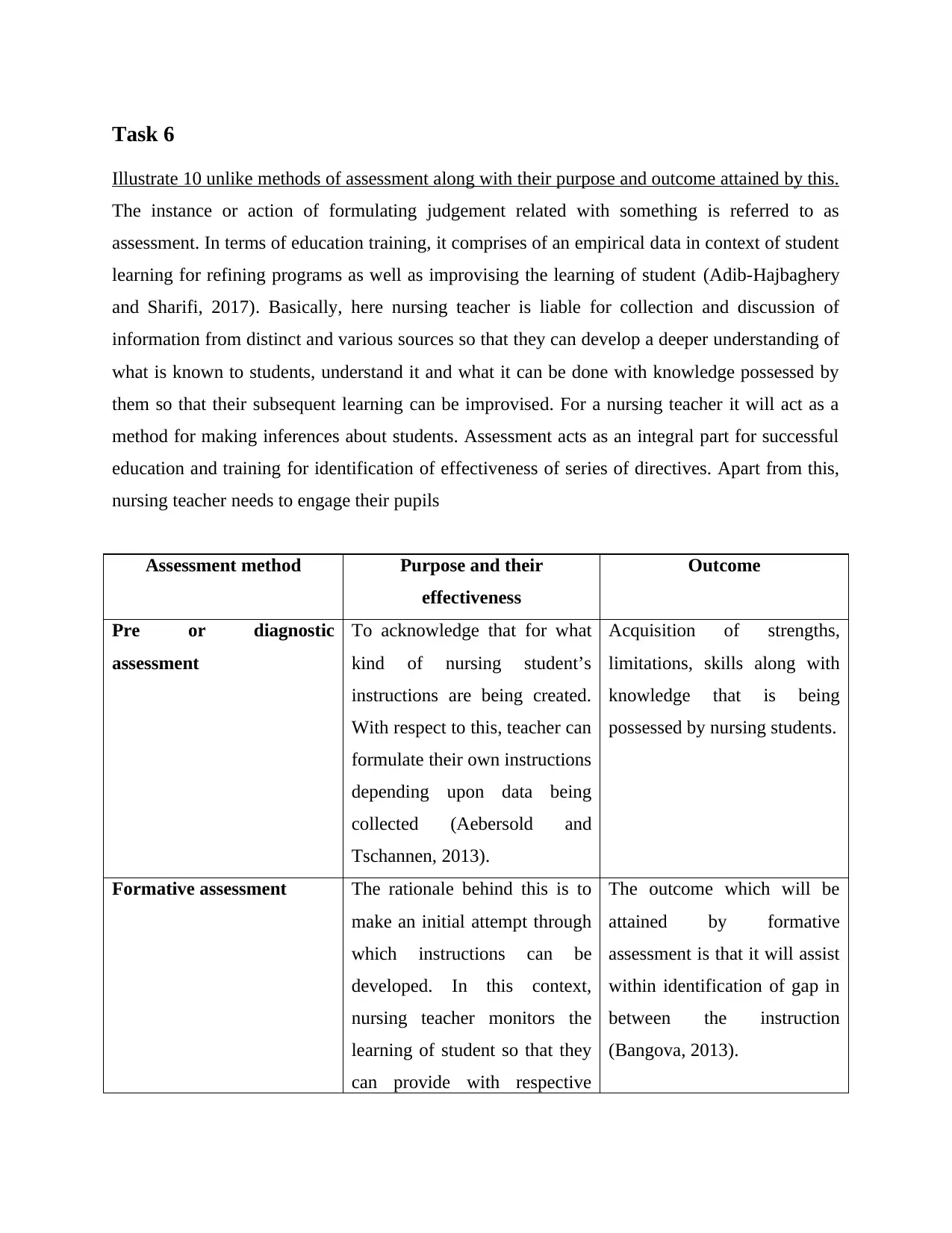
Task 6
Illustrate 10 unlike methods of assessment along with their purpose and outcome attained by this.
The instance or action of formulating judgement related with something is referred to as
assessment. In terms of education training, it comprises of an empirical data in context of student
learning for refining programs as well as improvising the learning of student (Adib-Hajbaghery
and Sharifi, 2017). Basically, here nursing teacher is liable for collection and discussion of
information from distinct and various sources so that they can develop a deeper understanding of
what is known to students, understand it and what it can be done with knowledge possessed by
them so that their subsequent learning can be improvised. For a nursing teacher it will act as a
method for making inferences about students. Assessment acts as an integral part for successful
education and training for identification of effectiveness of series of directives. Apart from this,
nursing teacher needs to engage their pupils
Assessment method Purpose and their
effectiveness
Outcome
Pre or diagnostic
assessment
To acknowledge that for what
kind of nursing student’s
instructions are being created.
With respect to this, teacher can
formulate their own instructions
depending upon data being
collected (Aebersold and
Tschannen, 2013).
Acquisition of strengths,
limitations, skills along with
knowledge that is being
possessed by nursing students.
Formative assessment The rationale behind this is to
make an initial attempt through
which instructions can be
developed. In this context,
nursing teacher monitors the
learning of student so that they
can provide with respective
The outcome which will be
attained by formative
assessment is that it will assist
within identification of gap in
between the instruction
(Bangova, 2013).
Illustrate 10 unlike methods of assessment along with their purpose and outcome attained by this.
The instance or action of formulating judgement related with something is referred to as
assessment. In terms of education training, it comprises of an empirical data in context of student
learning for refining programs as well as improvising the learning of student (Adib-Hajbaghery
and Sharifi, 2017). Basically, here nursing teacher is liable for collection and discussion of
information from distinct and various sources so that they can develop a deeper understanding of
what is known to students, understand it and what it can be done with knowledge possessed by
them so that their subsequent learning can be improvised. For a nursing teacher it will act as a
method for making inferences about students. Assessment acts as an integral part for successful
education and training for identification of effectiveness of series of directives. Apart from this,
nursing teacher needs to engage their pupils
Assessment method Purpose and their
effectiveness
Outcome
Pre or diagnostic
assessment
To acknowledge that for what
kind of nursing student’s
instructions are being created.
With respect to this, teacher can
formulate their own instructions
depending upon data being
collected (Aebersold and
Tschannen, 2013).
Acquisition of strengths,
limitations, skills along with
knowledge that is being
possessed by nursing students.
Formative assessment The rationale behind this is to
make an initial attempt through
which instructions can be
developed. In this context,
nursing teacher monitors the
learning of student so that they
can provide with respective
The outcome which will be
attained by formative
assessment is that it will assist
within identification of gap in
between the instruction
(Bangova, 2013).
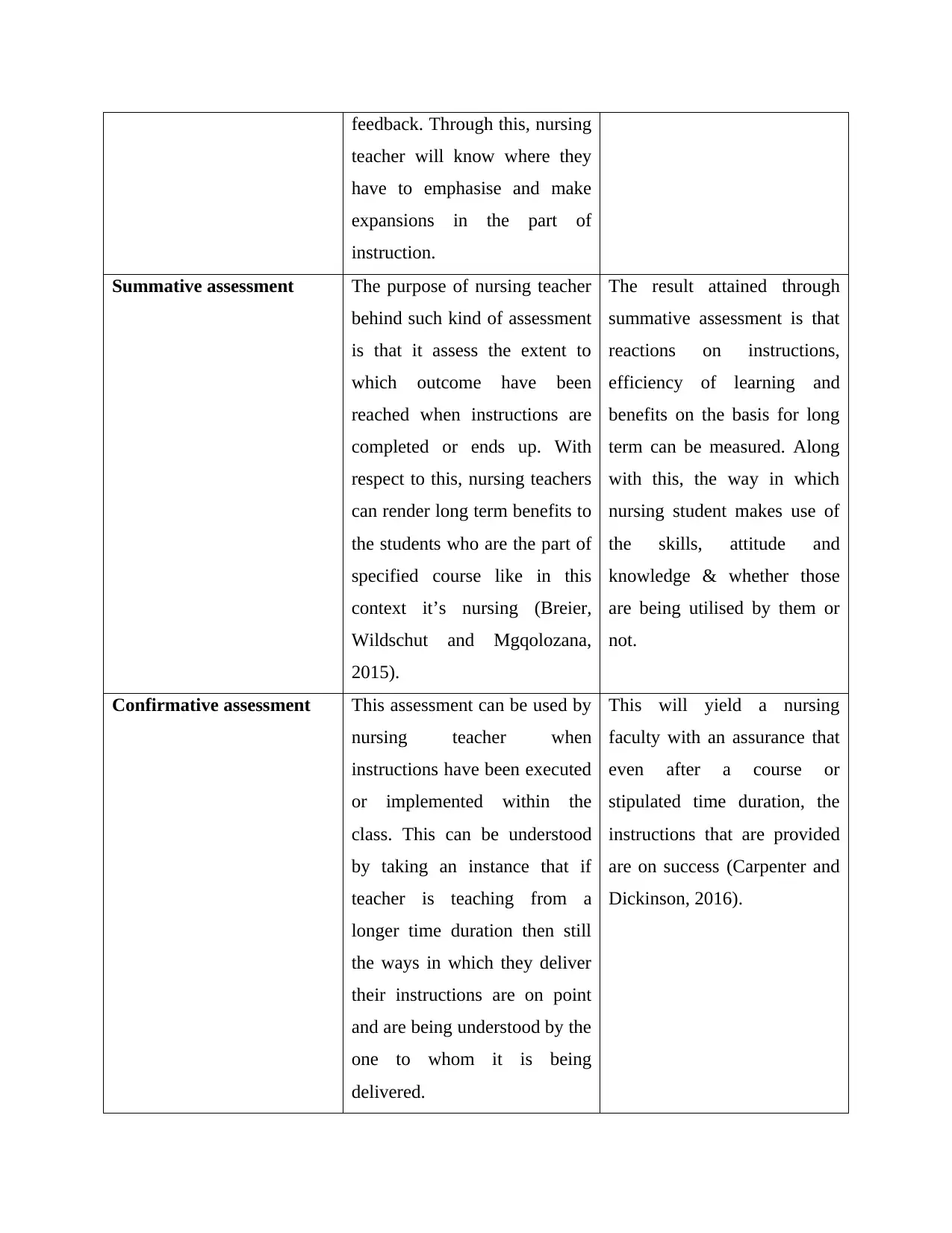
feedback. Through this, nursing
teacher will know where they
have to emphasise and make
expansions in the part of
instruction.
Summative assessment The purpose of nursing teacher
behind such kind of assessment
is that it assess the extent to
which outcome have been
reached when instructions are
completed or ends up. With
respect to this, nursing teachers
can render long term benefits to
the students who are the part of
specified course like in this
context it’s nursing (Breier,
Wildschut and Mgqolozana,
2015).
The result attained through
summative assessment is that
reactions on instructions,
efficiency of learning and
benefits on the basis for long
term can be measured. Along
with this, the way in which
nursing student makes use of
the skills, attitude and
knowledge & whether those
are being utilised by them or
not.
Confirmative assessment This assessment can be used by
nursing teacher when
instructions have been executed
or implemented within the
class. This can be understood
by taking an instance that if
teacher is teaching from a
longer time duration then still
the ways in which they deliver
their instructions are on point
and are being understood by the
one to whom it is being
delivered.
This will yield a nursing
faculty with an assurance that
even after a course or
stipulated time duration, the
instructions that are provided
are on success (Carpenter and
Dickinson, 2016).
teacher will know where they
have to emphasise and make
expansions in the part of
instruction.
Summative assessment The purpose of nursing teacher
behind such kind of assessment
is that it assess the extent to
which outcome have been
reached when instructions are
completed or ends up. With
respect to this, nursing teachers
can render long term benefits to
the students who are the part of
specified course like in this
context it’s nursing (Breier,
Wildschut and Mgqolozana,
2015).
The result attained through
summative assessment is that
reactions on instructions,
efficiency of learning and
benefits on the basis for long
term can be measured. Along
with this, the way in which
nursing student makes use of
the skills, attitude and
knowledge & whether those
are being utilised by them or
not.
Confirmative assessment This assessment can be used by
nursing teacher when
instructions have been executed
or implemented within the
class. This can be understood
by taking an instance that if
teacher is teaching from a
longer time duration then still
the ways in which they deliver
their instructions are on point
and are being understood by the
one to whom it is being
delivered.
This will yield a nursing
faculty with an assurance that
even after a course or
stipulated time duration, the
instructions that are provided
are on success (Carpenter and
Dickinson, 2016).
⊘ This is a preview!⊘
Do you want full access?
Subscribe today to unlock all pages.

Trusted by 1+ million students worldwide
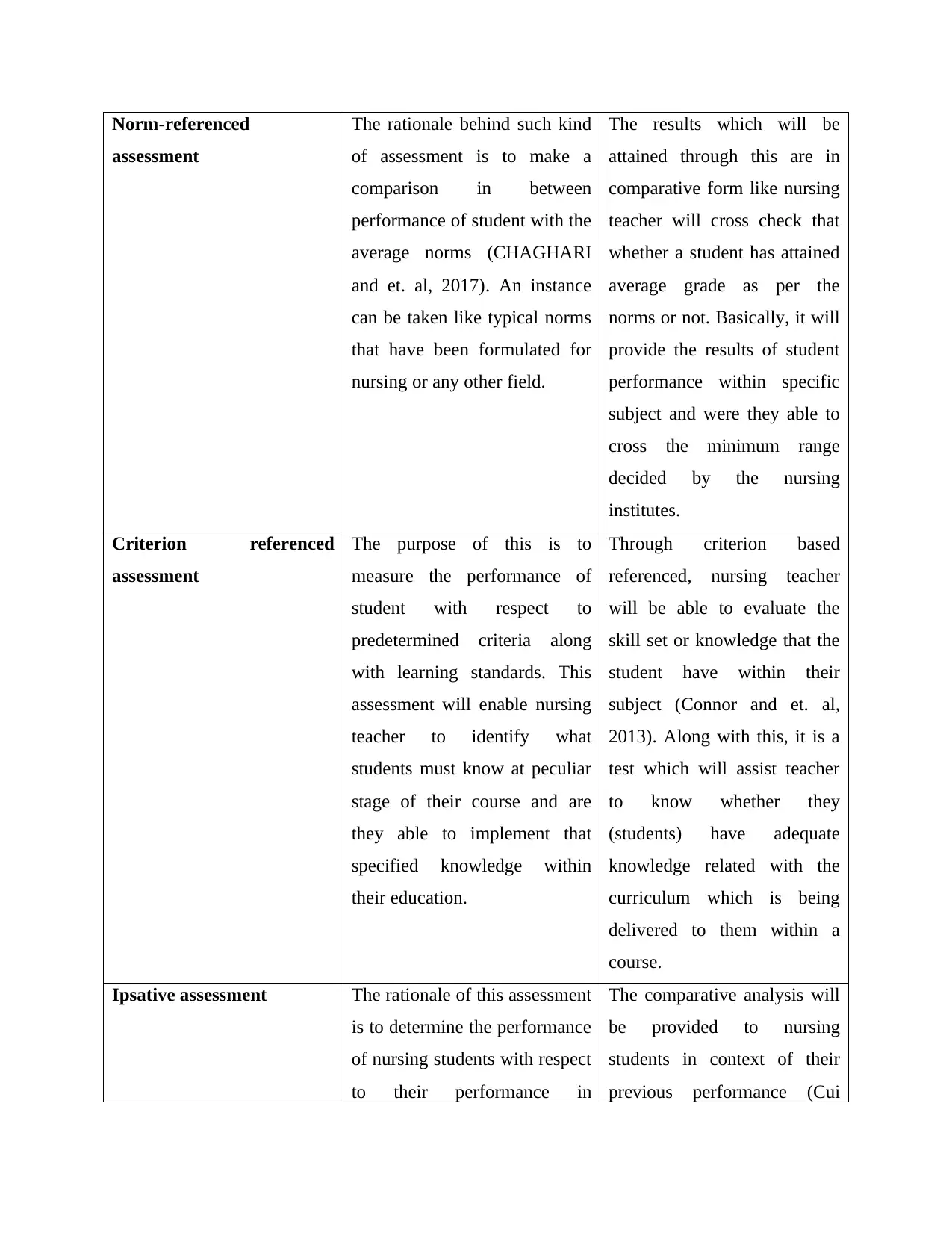
Norm-referenced
assessment
The rationale behind such kind
of assessment is to make a
comparison in between
performance of student with the
average norms (CHAGHARI
and et. al, 2017). An instance
can be taken like typical norms
that have been formulated for
nursing or any other field.
The results which will be
attained through this are in
comparative form like nursing
teacher will cross check that
whether a student has attained
average grade as per the
norms or not. Basically, it will
provide the results of student
performance within specific
subject and were they able to
cross the minimum range
decided by the nursing
institutes.
Criterion referenced
assessment
The purpose of this is to
measure the performance of
student with respect to
predetermined criteria along
with learning standards. This
assessment will enable nursing
teacher to identify what
students must know at peculiar
stage of their course and are
they able to implement that
specified knowledge within
their education.
Through criterion based
referenced, nursing teacher
will be able to evaluate the
skill set or knowledge that the
student have within their
subject (Connor and et. al,
2013). Along with this, it is a
test which will assist teacher
to know whether they
(students) have adequate
knowledge related with the
curriculum which is being
delivered to them within a
course.
Ipsative assessment The rationale of this assessment
is to determine the performance
of nursing students with respect
to their performance in
The comparative analysis will
be provided to nursing
students in context of their
previous performance (Cui
assessment
The rationale behind such kind
of assessment is to make a
comparison in between
performance of student with the
average norms (CHAGHARI
and et. al, 2017). An instance
can be taken like typical norms
that have been formulated for
nursing or any other field.
The results which will be
attained through this are in
comparative form like nursing
teacher will cross check that
whether a student has attained
average grade as per the
norms or not. Basically, it will
provide the results of student
performance within specific
subject and were they able to
cross the minimum range
decided by the nursing
institutes.
Criterion referenced
assessment
The purpose of this is to
measure the performance of
student with respect to
predetermined criteria along
with learning standards. This
assessment will enable nursing
teacher to identify what
students must know at peculiar
stage of their course and are
they able to implement that
specified knowledge within
their education.
Through criterion based
referenced, nursing teacher
will be able to evaluate the
skill set or knowledge that the
student have within their
subject (Connor and et. al,
2013). Along with this, it is a
test which will assist teacher
to know whether they
(students) have adequate
knowledge related with the
curriculum which is being
delivered to them within a
course.
Ipsative assessment The rationale of this assessment
is to determine the performance
of nursing students with respect
to their performance in
The comparative analysis will
be provided to nursing
students in context of their
previous performance (Cui
Paraphrase This Document
Need a fresh take? Get an instant paraphrase of this document with our AI Paraphraser
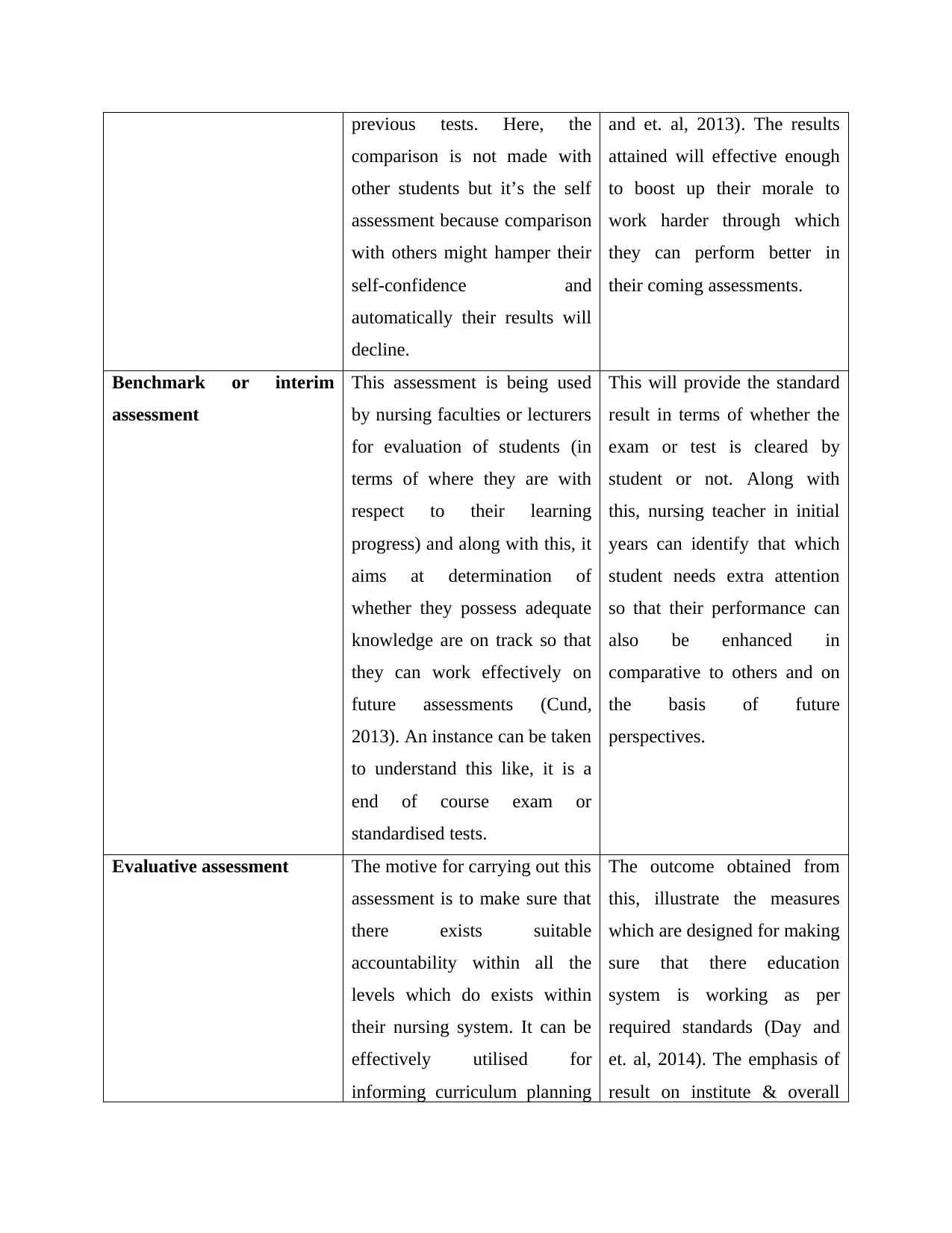
previous tests. Here, the
comparison is not made with
other students but it’s the self
assessment because comparison
with others might hamper their
self-confidence and
automatically their results will
decline.
and et. al, 2013). The results
attained will effective enough
to boost up their morale to
work harder through which
they can perform better in
their coming assessments.
Benchmark or interim
assessment
This assessment is being used
by nursing faculties or lecturers
for evaluation of students (in
terms of where they are with
respect to their learning
progress) and along with this, it
aims at determination of
whether they possess adequate
knowledge are on track so that
they can work effectively on
future assessments (Cund,
2013). An instance can be taken
to understand this like, it is a
end of course exam or
standardised tests.
This will provide the standard
result in terms of whether the
exam or test is cleared by
student or not. Along with
this, nursing teacher in initial
years can identify that which
student needs extra attention
so that their performance can
also be enhanced in
comparative to others and on
the basis of future
perspectives.
Evaluative assessment The motive for carrying out this
assessment is to make sure that
there exists suitable
accountability within all the
levels which do exists within
their nursing system. It can be
effectively utilised for
informing curriculum planning
The outcome obtained from
this, illustrate the measures
which are designed for making
sure that there education
system is working as per
required standards (Day and
et. al, 2014). The emphasis of
result on institute & overall
comparison is not made with
other students but it’s the self
assessment because comparison
with others might hamper their
self-confidence and
automatically their results will
decline.
and et. al, 2013). The results
attained will effective enough
to boost up their morale to
work harder through which
they can perform better in
their coming assessments.
Benchmark or interim
assessment
This assessment is being used
by nursing faculties or lecturers
for evaluation of students (in
terms of where they are with
respect to their learning
progress) and along with this, it
aims at determination of
whether they possess adequate
knowledge are on track so that
they can work effectively on
future assessments (Cund,
2013). An instance can be taken
to understand this like, it is a
end of course exam or
standardised tests.
This will provide the standard
result in terms of whether the
exam or test is cleared by
student or not. Along with
this, nursing teacher in initial
years can identify that which
student needs extra attention
so that their performance can
also be enhanced in
comparative to others and on
the basis of future
perspectives.
Evaluative assessment The motive for carrying out this
assessment is to make sure that
there exists suitable
accountability within all the
levels which do exists within
their nursing system. It can be
effectively utilised for
informing curriculum planning
The outcome obtained from
this, illustrate the measures
which are designed for making
sure that there education
system is working as per
required standards (Day and
et. al, 2014). The emphasis of
result on institute & overall
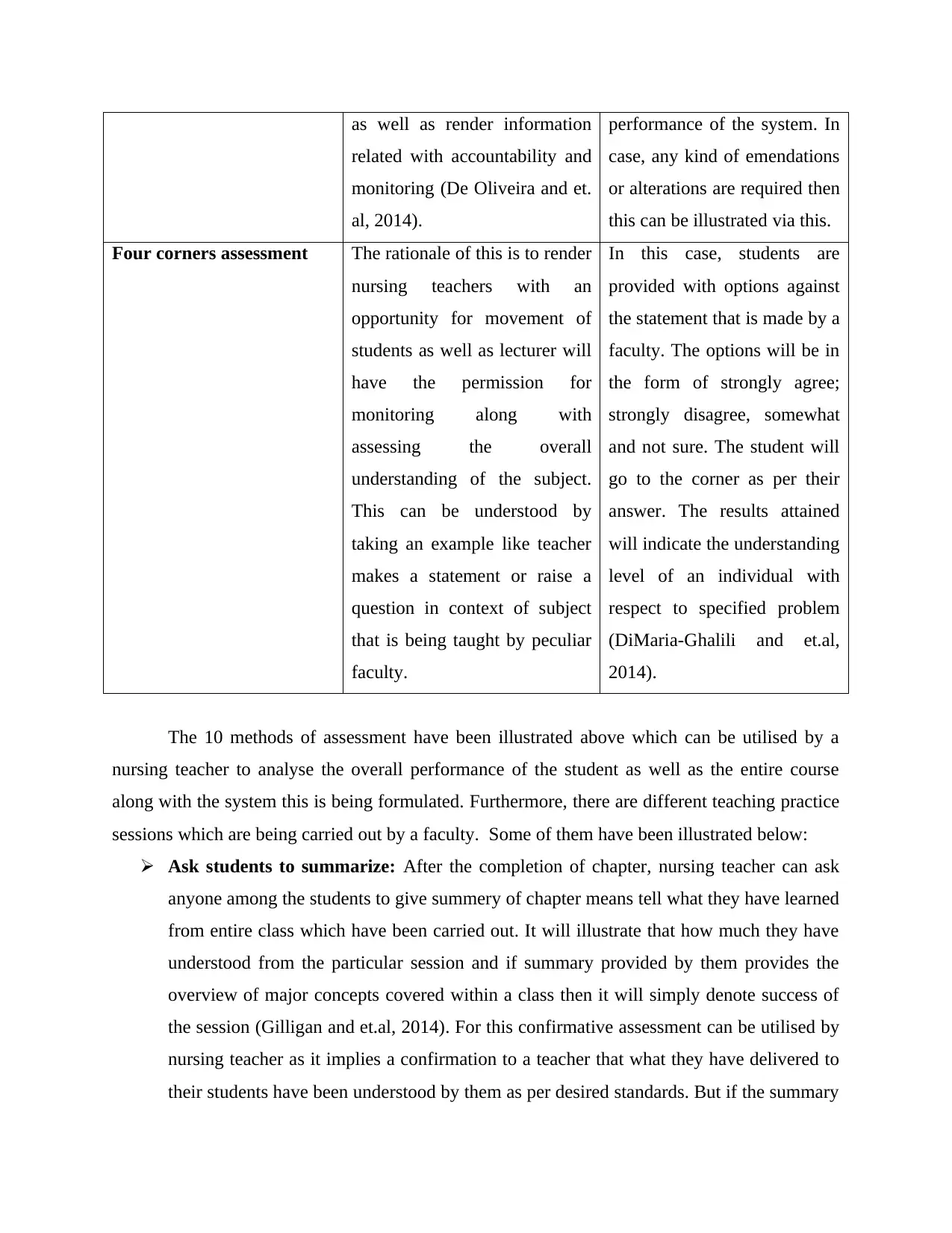
as well as render information
related with accountability and
monitoring (De Oliveira and et.
al, 2014).
performance of the system. In
case, any kind of emendations
or alterations are required then
this can be illustrated via this.
Four corners assessment The rationale of this is to render
nursing teachers with an
opportunity for movement of
students as well as lecturer will
have the permission for
monitoring along with
assessing the overall
understanding of the subject.
This can be understood by
taking an example like teacher
makes a statement or raise a
question in context of subject
that is being taught by peculiar
faculty.
In this case, students are
provided with options against
the statement that is made by a
faculty. The options will be in
the form of strongly agree;
strongly disagree, somewhat
and not sure. The student will
go to the corner as per their
answer. The results attained
will indicate the understanding
level of an individual with
respect to specified problem
(DiMaria-Ghalili and et.al,
2014).
The 10 methods of assessment have been illustrated above which can be utilised by a
nursing teacher to analyse the overall performance of the student as well as the entire course
along with the system this is being formulated. Furthermore, there are different teaching practice
sessions which are being carried out by a faculty. Some of them have been illustrated below:
Ask students to summarize: After the completion of chapter, nursing teacher can ask
anyone among the students to give summery of chapter means tell what they have learned
from entire class which have been carried out. It will illustrate that how much they have
understood from the particular session and if summary provided by them provides the
overview of major concepts covered within a class then it will simply denote success of
the session (Gilligan and et.al, 2014). For this confirmative assessment can be utilised by
nursing teacher as it implies a confirmation to a teacher that what they have delivered to
their students have been understood by them as per desired standards. But if the summary
related with accountability and
monitoring (De Oliveira and et.
al, 2014).
performance of the system. In
case, any kind of emendations
or alterations are required then
this can be illustrated via this.
Four corners assessment The rationale of this is to render
nursing teachers with an
opportunity for movement of
students as well as lecturer will
have the permission for
monitoring along with
assessing the overall
understanding of the subject.
This can be understood by
taking an example like teacher
makes a statement or raise a
question in context of subject
that is being taught by peculiar
faculty.
In this case, students are
provided with options against
the statement that is made by a
faculty. The options will be in
the form of strongly agree;
strongly disagree, somewhat
and not sure. The student will
go to the corner as per their
answer. The results attained
will indicate the understanding
level of an individual with
respect to specified problem
(DiMaria-Ghalili and et.al,
2014).
The 10 methods of assessment have been illustrated above which can be utilised by a
nursing teacher to analyse the overall performance of the student as well as the entire course
along with the system this is being formulated. Furthermore, there are different teaching practice
sessions which are being carried out by a faculty. Some of them have been illustrated below:
Ask students to summarize: After the completion of chapter, nursing teacher can ask
anyone among the students to give summery of chapter means tell what they have learned
from entire class which have been carried out. It will illustrate that how much they have
understood from the particular session and if summary provided by them provides the
overview of major concepts covered within a class then it will simply denote success of
the session (Gilligan and et.al, 2014). For this confirmative assessment can be utilised by
nursing teacher as it implies a confirmation to a teacher that what they have delivered to
their students have been understood by them as per desired standards. But if the summary
⊘ This is a preview!⊘
Do you want full access?
Subscribe today to unlock all pages.

Trusted by 1+ million students worldwide
1 out of 27
Related Documents
Your All-in-One AI-Powered Toolkit for Academic Success.
+13062052269
info@desklib.com
Available 24*7 on WhatsApp / Email
![[object Object]](/_next/static/media/star-bottom.7253800d.svg)
Unlock your academic potential
Copyright © 2020–2025 A2Z Services. All Rights Reserved. Developed and managed by ZUCOL.



